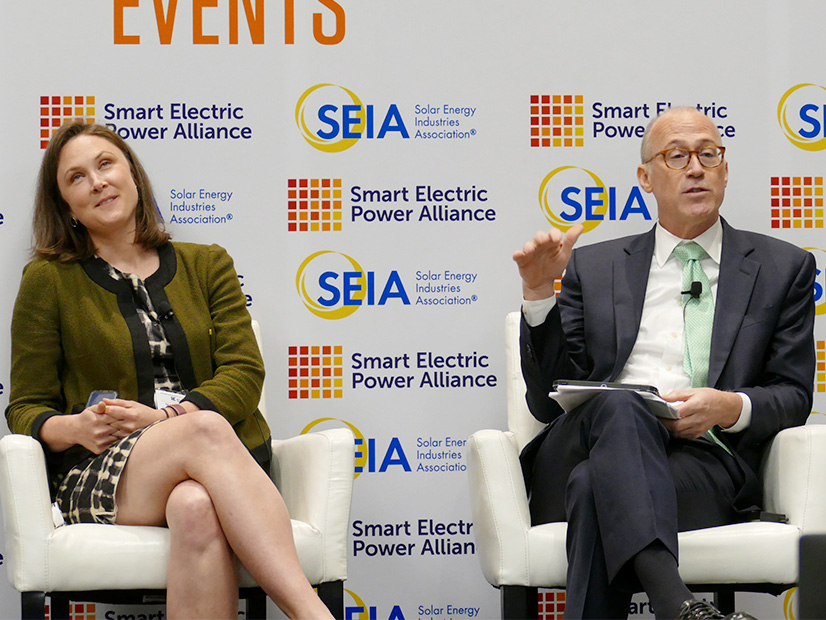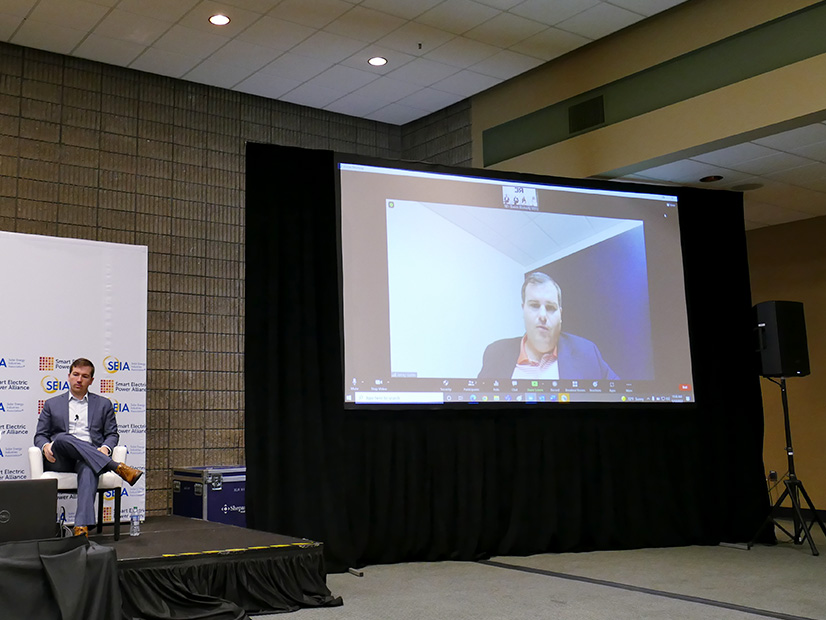
ATLANTA — A Southern Co. (NYSE:SO) official gamely defended the Southeast Energy Exchange Market (SEEM) last week in a debate with RTO proponents at the RE+ Southeast conference.
Noel Black, Southern’s vice president of federal regulatory affairs and chair of SEEM’s board of directors, battled with three skeptics at the conference, sponsored by the Solar Energy Industries Association (SEIA) and Smart Electric Power Alliance (SEPA).
More than a dozen utilities and cooperatives, including Southern, the Tennessee Valley Authority and Duke Energy (NYSE:DUK), proposed SEEM to reduce the “friction” in bilateral trading by introducing automation, eliminating transmission rate pancaking and allowing 15-minute energy transactions. It is expected to be operational in the third quarter of this year.
Black said SEEM would reduce curtailments of solar power and provide consumers cheaper power than an RTO.
“We wanted to get out of the way of solar, so if your loads are low in the shoulder periods, you have somebody else’s territory to take that energy. So it’s a really efficient way of dealing with that,” he said.
Others on the panel, however, said SEEM’s bilateral trading and limited transparency fall far short of what’s needed to incorporate as much renewable power as is required by efforts to decarbonize by midcentury.
“We believe that some type of wholesale market that’s organized in the Southeast is critical for integrating renewable energy, encouraging development and reducing emissions at the scale that’s required to actively combat climate change,” said Nick Guidi, federal energy regulatory attorney for the Southern Environmental Law Center.
Jamey Goldin, Google’s (NASDAQ:GOOG) energy regulatory counsel for global energy markets and policy, noted that the company has pledged to match its loads to carbon-free generation around the clock. “Just last week, we [committed] to net zero across all lines, including Pixel, Pixelbook, everything; it’s not just data centers anymore,” he said.
‘Nothing Burger’
But he said delivering on that commitment will be most difficult in Asia and the Southeastern U.S.
“Our carbon-free energy [availability] is abysmal in the Southeast, and we’re not going to get there without an RTO. … It’s just not going to happen,” he said, dismissing SEEM as “a nothing burger.”
“When you have true competition, a true, free market for generation, you have economic dispatch and multilateral opportunities for buyers and renewable developers to work together,” he said, citing Google’s work with AES to aggregate renewable projects in PJM. The economies of scale provided by such projects are “impossible in any of these vertically integrated monopoly states,” he said.
“I don’t know what the technical definition of a ‘nothing burger’ is, but it’s definitely not what SEEM is,” Black responded.

He and Goldin cited widely varying statistics on the installed solar power in the three states in which Southern operates. According to February 2022 data from the Energy Information Administration, Georgia ranks sixth among states with 3,088 MW. Alabama was 23rd with 424 MW, and Mississippi ranked 30th with 219 MW.
At a time when natural gas prices have more than doubled to $8/MMBtu, Black said SEEM’s joint dispatch, which will charge customers based on the weighted average cost of fuel, is better for consumers than the single price clearing mechanism used by RTOs.
“Let’s just say you have 80% of your generation from wind or solar. Pretty cheap, right? … Twenty percent of the energy is coming from gas at $8. You set a price at $8. I can’t quite understand how that’s fair to customers, so that they can’t see the real cost of that energy,” Black said. “That’s something that’s going to be under a lot of pressure as RTOs move ahead and get more zero-marginal-cost” resources.
SEEM’s website cites EIA data showing SEEM members’ average rates are below U.S. and RTO averages.
‘True Competition’
Black said SEEM provides “true competition” that would be lacking if a utility cedes to an RTO its transmission operations and planning, “the very things that differentiate me and my ability to best serve my customers.”
“I want to be held accountable. And with accountability comes the opportunity to differentiate. If I turn that over to someone else, you lose competition. It’s just a fact. I mean, I compete by doing the best job of serving my customers reliable, sustainable, affordable energy.”
Maggie Shober, director of utility reform for the Southern Alliance for Clean Energy (SACE), rejected Black’s definition of competition.
“We have this vertically integrated model [in which] you are able to set the rules, largely, on rooftop solar; you control a lot of the energy efficiency. Many customers literally do not have a choice except for their monopoly utility. And so calling that competition, I think, is a misuse of the term, quite frankly.”
Market Oversight
Guidi said SEEM won’t generate real-time energy market prices that would provide price signals to spur renewable development.
He also cited the lack of an independent market monitor to police market power and market manipulation.
“SEEM allows all market participants to toggle off other participants so they can choose who not to trade with. And we think this could be problematic if utilities … decide not to buy from [independent power producers], or merchant generators,” he said. “They might have a cost incentive to buy from them on an individual trade basis. But if they want to favor their generation long term, they might not want to provide those investment opportunities for developers to enter the market.”
He also noted that only load-serving entities will have a say in SEEM’s governance. “There’s no real stakeholder process where customers are represented, public interest organizations are represented, states are represented. And we think that’s problematic, because to have a real thorough market reform in the Southeast, everybody needs to be involved.”
Black insisted there is no incentive for SEEM members to discourage participation. “We’re doing everything in the world to outreach, to focus on participation,” he said. “I have heard that criticism that there’s an opportunity for us to hold people [out]. … It happens not to be true. We want you in the market; we encourage you to be in a market. That will be good for our customers.”
SEEM recently had the first of three webinars for potential participants, with additional sessions set for May 20 and June 2. (See SEEM Members Launch Engagement Series for Participants.)
Black also said he was encouraged that more utilities in Florida are studying whether to join the effort. “I have a good feeling that hopefully in 2023 … they’re likely to join SEEM as well,” he said. Duke, whose Carolina utilities are part of SEEM, had previously expressed concern over peninsular Florida’s limited interconnections to the rest of the Southeast; PowerSouth Energy Cooperative, which serves the state’s panhandle, is already a member.
He also cited the clogged interconnection queues in RTOs such as PJM and MISO. “Southern Co. doesn’t have an interconnection problem,” he said.
‘Missed Opportunity’
Shober said SEEM is a “missed opportunity” for customers, citing SACE’s analysis that SEEM would save only $1 per customer per year.
She agreed that “there are issues with a lot of RTO structures out there.”
“So in the Southeast, I see that as a huge opportunity. We’re not trying to work within an existing system that was set up in the ’90s, before we had … all the benefits and technologies that we have today,” she said. “We know that the Southeastern utilities can come together and talk through this because they did so to develop SEEM. Let’s take that to the next level. Let’s look at, what does this Southeast RTO look like? Can we get there? I don’t think it’s going to happen in five years. But can we get there in in 10 years?”
Southern Co. “seems pretty happy with the trajectory we’re on,” Shober observed. “We’re not happy with the trajectory that we’re seeing in the Southeast. We look at [integrated resource plans] every year. We have some IRPs and some utilities that are not on track to get to zero carbon until after 2100 — not even 2050.
“We have a lot of work to do. And it’s just not going to happen in the current status quo.”


